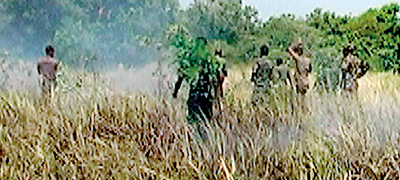News
Fires consume 15, 000 acres of forest and grassland
mostly the result of human carelessness, rather than any monkey business, writes Malaka Rodrigo
The Ramayana legend says that when the Sinhala soldiers captured Hanuman, they set the Monkey King’s tail on fire. In revenge, Hanuman jumped from roof to roof and set the entire Sinhala kingdom on fire.
It may seem that a similarly angry entity is responsible for the spate of fires that have broken out across the drought-hit country. More than 155 forest fires have occurred in the past 150 days, according to Disaster Management Centre (DMC) spokesperson Sarath Lal Kumara. That amounts to almost one fire per day.

Locals join in to help Disaster Management Centre check fires.
Between April and August, fires destroyed 15,000 acres of forest and grassland. Most of the forest fires occurred in the Badulla, Moneragala and Nuwara Eliya districts.
The worst fire this year raged through jungle between Ohiya and Pattipola early last month. The fire destroyed 1,500 acres of forest and even disrupted hill country train services. The fire could have been started by something as small and insignificant as a lighted cigarette butt thrown from a passing train. The second biggest fire occurred in the Knuckles Range, where more than 500 acres of jungle were destroyed. “The long spell of drought has fuelled the fires,” Mr. Kumara told the Sunday Times.
Whenever a forest fire breaks out, the DMC works with the local community and local administration to fight the flames. The Sri Lanka Air Force has frequently flown to the rescue by dropping water from aircraft to control fires in inaccessible areas. Fires have also broken out in catchment areas near tanks and reservoirs.
These recent forest fires have not destroyed native forest cover, according to Professor Nimal Gunathilake of the Department of Botany, at the University of Peradeniya. The areas affected are either grassland or plantations of eucalyptus or pinus.
Almost all forest fires in Sri Lanka are “man-made” – sparked by human action, through accident or design. Forest Department sources say farmers sometimes set dead grass alight to clear land to grow fresh grass for cattle, and these fires can spread to adjacent forests. Farmers also burn down degraded forests to clear land for cultivation purposes.
Hunters start fires to drive animals out into the open. The Ohiya fire could have been sparked by a lighted cigarette butt thrown from a train or dropped by someone walking through a forest. The burning of debris by labourers working on highways and railways is another fire hazard.
Not everyone stops to think about the death toll of wildlife that fall victim to forest fires. A jungle fire is a death trap for any slow-moving animal. Last week, villagers rescued a python from a forest fire.
Follow @timesonlinelk
comments powered by Disqus



















